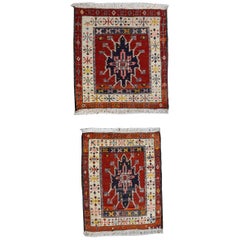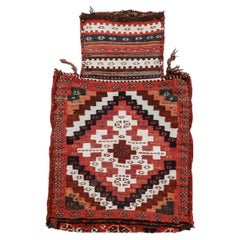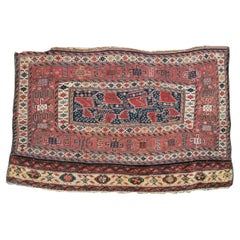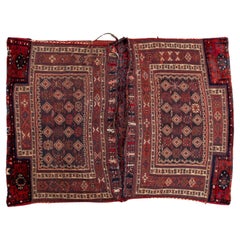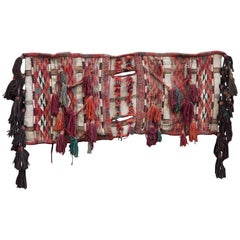Bakhtiari Bag
Pair of Early 20th Century Bakhtiari Bag Face Rugs
Located in Chicago, IL
A wonderful sweet pair of early 20th century Persian Bakhtiari bag face rugs, each with a geometric
Category
Mid-20th Century Persian Tribal Persian Rugs
Materials
Wool
Antique Persian Luri Bakhtiari Flatwoven Salt Bag in Cotton, c. 1900
Located in San Francisco, CA
Antique Southwest Persian Luri Bakhtiari Flatwoven Cotton Salt Bag, c. 1900
This Luri-Bakhtiari
Category
Antique 19th Century Persian Tribal Art
Materials
Cotton
Exceptional Antique Persian Bakhtiari Sumak Bagface, 19th Century
Located in San Francisco, CA
Exceptional Antique Persian Bakhtiari Sumak Bagface, 19th Century
Flat woven bags executed in
Category
Antique 19th Century Persian Tribal Art
Materials
Wool
Recent Sales
Antique Horse Saddle Pad, Persian Bag
Located in RÉDING, FR
"Antique Horse Saddle Pad, Persian Bag"
COMPLETE CHUVAL, BAKHTIARI TRIBUS, CHAHAR MAHAL, WESTERN
Category
Early 20th Century Persian Other Persian Rugs
Materials
Wool
Bakhtiari Camel Bag
Located in Antwerp, BE
Super high quality Bakhtiari camel bag from west central Iran. Handwoven with vibrant natural dyes
Category
Early 20th Century Persian Hollywood Regency Tapestries
Materials
Wool
Fantastic Early 20th Century Bakhtiari Saddle Bag
Located in Chicago, IL
A fantastic early 20th century Persian Bakhtiari saddle bag with a beautiful woven geometric
Category
Vintage 1920s Persian Bakshaish Persian Rugs
Materials
Leather, Wool
People Also Browsed
Gian Franco Legler Pair of Rattan and Metal "Basket" Chairs, 1950s
By Gian Franco Legler
Located in Naples, IT
Pair of Basket model stackable chairs designed by Italian-Swiss designer Gian Franco Legler with a honey-colored woven rattan seat and a black metal base. They are in good condition ...
Category
Vintage 1950s Swiss Mid-Century Modern Chairs
Materials
Metal
$1,546 / set
H 31.5 in W 18.51 in D 17.72 in
Antique Moroccan Moorish Silk Textile Tapestry Wall Hanging Hiti
Located in Moreno Valley, CA
Antique Moroccan Moorish Silk Textile Tapestry Wall Hanging Hiti
Ottoman voided silk velvet wall covering.
Silk velvet cut designs, light browns, yellow, cream and blue, the panel co...
Category
Early 20th Century Moroccan Moorish Tapestries
Materials
Silk
$3,500 / item
H 62 in W 53 in D 0.5 in
Contemporary Ceramic Tulipano Corteccia Texture Coral Vase
By Paola Paronetto
Located in Porcia, IT
Merging modern design with innovative artistic sensibility, this vase is a daring exercise in balance and visual harmony. Fashioned by artist Paola Paronetto using her signature pape...
Category
2010s Italian Modern Vases
Materials
Ceramic
$958 / item
H 25.6 in W 13.78 in D 13.78 in
Contemporary Ceramic Cartoccio Texture Fide Yellow Vase
By Paola Paronetto
Located in Porcia, IT
Combining tradition with innovation, ceramist Paola Paronetto's handcrafted pieces are designed for those who love to surround themselves with refined and exclusive objects. Part of ...
Category
2010s Italian Modern Vases
Materials
Ceramic
Contemporary Ceramic Cartocci Texture White and Gold Bowl #1
By Paola Paronetto
Located in Porcia, IT
Striking and stately, this bowl features dynamic horizontal and vertical ridges and a distinctive panel insert in gold, whose vibrant color and smooth surface elegantly contrast with...
Category
2010s Italian Modern Vases
Materials
Ceramic
$593 / item
H 7.88 in W 11.82 in D 11.82 in
Barovier Toso Murano Purple Gold Flecks Italian Art Glass Double Handle Vase
By Barovier&Toso, Ercole Barovier
Located in Kissimmee, FL
Beautiful, rare, vintage Murano hand blown gold flecks and dark purple trim Italian art glass ornate pierced handles vase. Documented to designer Ercole Barovier, for the Barovier e ...
Category
Vintage 1950s Italian Mid-Century Modern Vases
Materials
Gold Leaf
$1,200 Sale Price
20% Off
H 4.13 in W 3.25 in D 6.13 in
Marvellous Mosaic Ceramic Vase By Jean Gerbino For Vallauris, France
By Jean Gerbino
Located in Rothley, Leicestershire
Created by the master ceramicist Jean Gerbino for Vallauris, a superbly designed flared shaped vase with mosaic patterning in tones of leaf green, sage, sand and cream
Circa 1960's
S...
Category
Mid-20th Century French Mid-Century Modern Vases
Materials
Ceramic
$587 Sale Price
64% Off
H 7.75 in Dm 5.75 in
Oasis of Fire and Verdant Light: A Vintage Boujad Moroccan Masterpiece
By Berber Tribes of Morocco
Located in Dallas, TX
21497 Vintage Berber Moroccan Rug, 05'10 x 11'10. Bathed in a palette of sun-warmed coral, ember, and verdant green, this hand-knotted wool vintage Boujad Moroccan rug is an exclusiv...
Category
Late 20th Century Moroccan Tribal Moroccan and North African Rugs
Materials
Wool
Superb Petit Jean Gerbino, Vallauris, France, Ceramic Mosaic Posy Potpourri Vase
By Jean Gerbino
Located in Rothley, Leicestershire
Petit diamond motif Jean Gerbino for Vallauris, France, ceramic glazed mosaic posy potpourri vase
Wonderful patterns and colouring from Gerbino
Circa 1960's
Signed Gerbino to base
...
Category
Mid-20th Century French Mid-Century Modern Vases
Materials
Ceramic
$261 Sale Price
60% Off
H 3.5 in Dm 3.5 in
DAUM Pierre d'AVESN Large Floral Vase, 1920
By Daum, Pierre D'Avesn
Located in Saint-Amans-des-Cots, FR
French Art Deco glass vase by Pierre D'AVESN at DAUM'S (Croismare, Nancy), France, 1920s. Floral pattern. Stunning patina. Height: 7.5"(19cm), Diameter: 7.1"(18cm). Enameled "Lorrain...
Category
Vintage 1920s French Art Deco Vases
Materials
Glass
Vintage Turkish Oushak Rug with Traditional Style, Anatolian Prayer Rug
Located in Dallas, TX
52748 Vintage Anatolian Turkish Oushak Prayer Rug, 03'02 x 06'02. A piece of spiritual heritage and timeless artistry, this hand knotted wool vintage Turkish Oushak prayer rug offers...
Category
Early 20th Century Turkish Oushak Turkish Rugs
Materials
Wool
Antique Greek Embroidery from Eastern Europe in the Style of Ottoman Ones
Located in Istanbul, TR
The embroidery is in rather good condition and seems to been on a frame before my possession of the piece.
Category
Early 20th Century Macedonian Suzani Western European Rugs
Materials
Silk
Small French Vallauris Clay Mosaic Vase by Ceramicist Jean GERBINO
By Jean Gerbino
Located in New York, NY
A small French "clay mosaic" vase by ceramicist Jean Gerbino, mosaic patterning is in blue, cream, brown and greens. Signed on the bottom "Vallauris".
Measures:- Diameter: 3.5, He...
Category
Mid-20th Century French Mid-Century Modern Vases
Materials
Clay
Ceramic Plate Visage Gris 'Grey Face' A.R. 206 by Pablo Picasso & Madoura, 1953
By Madoura, Pablo Picasso
Located in New York, NY
The engraved and brush painted ceramic plate, Visage Gris (Grey Face) is one the most iconic pieces created by Pablo Picasso (1881 - 1973) at the Madoura workshop in Vallauris, Franc...
Category
Mid-20th Century French Mid-Century Modern Figurative Sculptures
Materials
Earthenware
On Hold
$37,000
H 1.63 in W 15.13 in D 12.38 in
Yuan Dynasty, Antique Chinese Green Glazed Pottery Covered Jar
Located in Sampantawong, TH
Chinese green glazed pottery covered jar.
Age: China, Yuan Dynasty, A.D. 1271 - 1368
Size: height 35 cm / width 25 cm.
Condition: Well-preserved old burial condition overall.
...
Category
Antique 15th Century and Earlier Chinese Antiquities
Materials
Pottery
$1,560 Sale Price
20% Off
H 13.78 in Dm 9.85 in
Bohemian 72 Floor Lamp, Rattan
By Gabriella Crespi, Gubi
Located in Berkeley, CA
GUBI's Bohemian floor lamp is a perfect example of designer Gabriella Crespi’s desire to create furniture that seamlessly moves from indoor to outdoor spaces. Made from rattan, the l...
Category
21st Century and Contemporary Danish Post-Modern Floor Lamps
Materials
Rattan
Get Updated with New Arrivals
Save "Bakhtiari Bag", and we’ll notify you when there are new listings in this category.
Bakhtiari Bag For Sale on 1stDibs
With a vast inventory of beautiful furniture at 1stDibs, we’ve got just the bakhtiari bag you’re looking for. Frequently made of fabric, wool and animal skin, every bakhtiari bag was constructed with great care. Find 40 options for an antique or vintage bakhtiari bag now, or shop our selection of 14 modern versions for a more contemporary example of this long-cherished piece. There are many kinds of the bakhtiari bag you’re looking for, from those produced as long ago as the 19th Century to those made as recently as the 21st Century. A bakhtiari bag made by modern designers — as well as those associated with Scandinavian Modern — is very popular.
How Much is a Bakhtiari Bag?
A bakhtiari bag can differ in price owing to various characteristics — the average selling price 1stDibs is $5,750, while the lowest priced sells for $875 and the highest can go for as much as $17,125.
